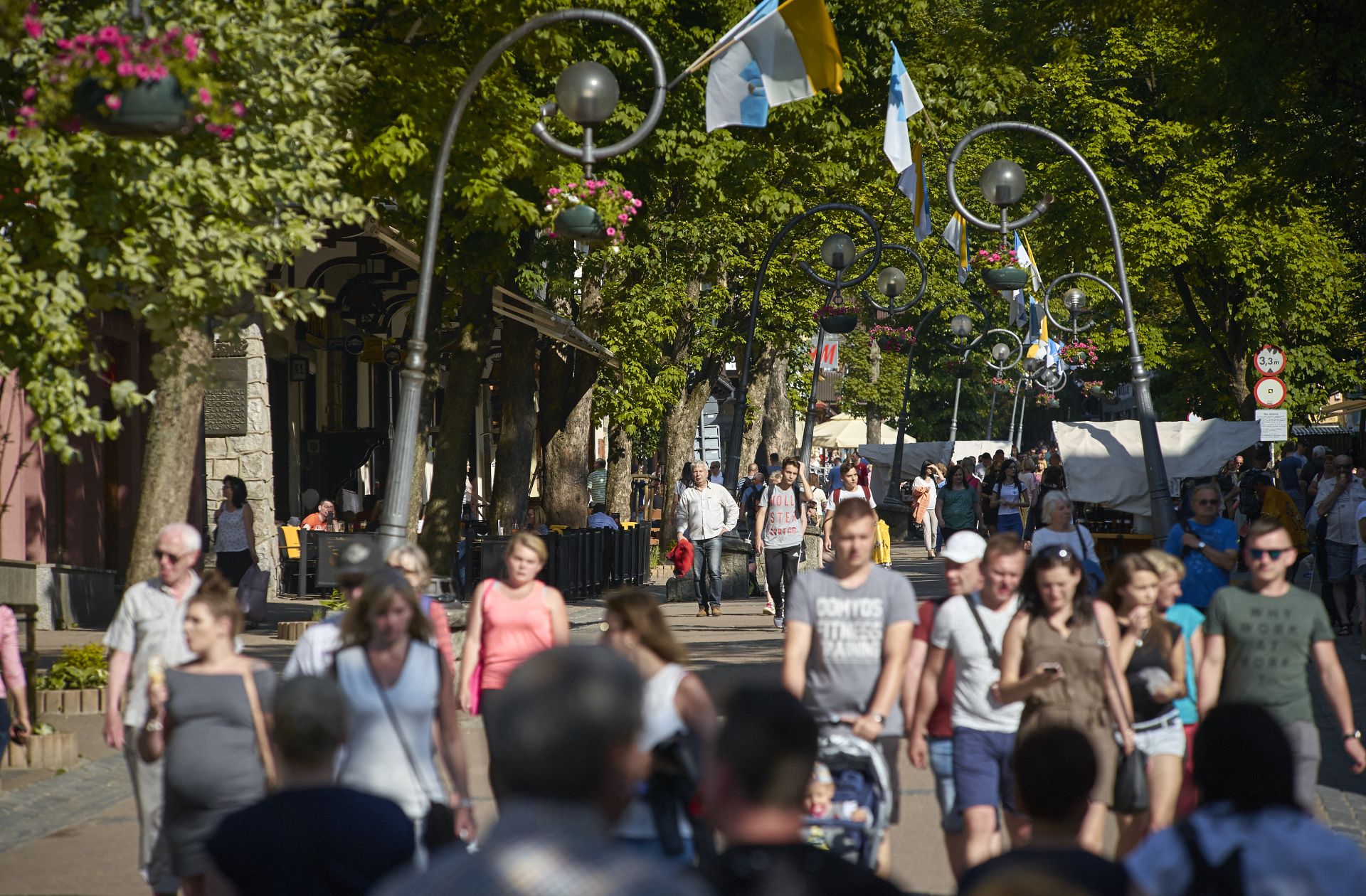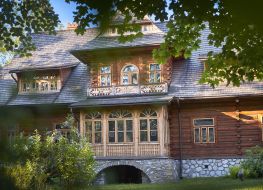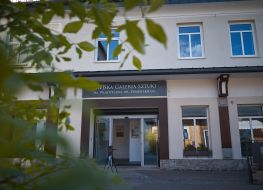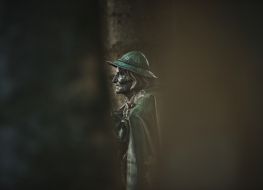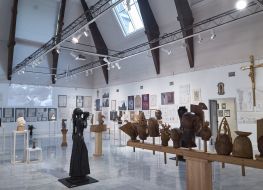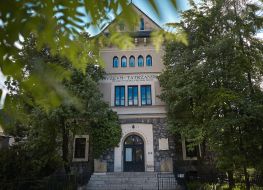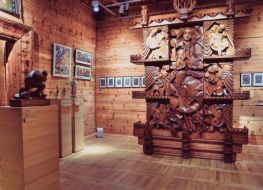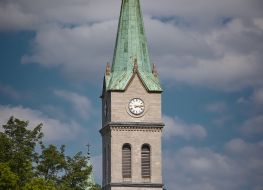The Krupówki promenade is Zakopane's showcase street. About 1 km long, in high seasonbrimming with visitors, hikers and backpackers, a perfect place for a leisurely stroll to get one's bearings around the centre of the resort. The name originates from the glade "Krupówki" that once belonged to the Krupa family. By the end of the 19th c. the original wooden houses that made both frontages of the street were gradually crowded out by a diversity of masonry town houses.
We start our tour at the bottom end of the Krupówki promenade, at the junction with the Kościeliska street.
The Sanctuary of the Holy Family, Krupówki 1a st.
The stone church dates back to the late 19th c. Its construction was commenced in 1877 by Fr. Józef Stolarczyk, the first parish priest of Zakopane, and concluded by Fr. Kazimierz Kaszelewski, who took over the Zakopane parish after Fr. Stolarczyk. It was consecrated in 1899, and subsequently was granted the status of a parish church, originally vested in the wooden Old Church at ul. Kościeliska.
A Neo-Romanesque structure, visibly influenced by the classic Zakopane style, the so-called "Zakopane way" promoted by Edgar Kováts, mock-Baroque and Art Deco of the early 20th c. (M. Pinkwart, L. Długołęcka Pinkwart). The interior boasts a number of components made to the original design of Stanisław Witkiewicz, including the altar in the side chapel of Our Lady of the Rosary in the left-hand aisle, the side chapel of St. John the Baptist, and the main entrance door to the church.
The Tatra Museum, Krupówki 10 st.
phone: +48 18 20 152 05
It is located in the bottom section of the Krupówki promenade, to the right, pushedslightly into the background. Its impressive brick structure, a true homage to the Zakopane style in architecture, was built in 1913 - 1922, to the original, joint design of Stanisław Witkiewicz (front of the building) and Franciszek Mączyński (technical implementation project). It accommodates the three permanent exhibitions addressing the historical background, ethnography, and natural history of the region.
In close proximity of the Museum there are two important buildings: Dworzec Tatrzański (ul. Krupówki 12) and the Zakopane Vocational and High School of Construction Trades.
We keep on walking uphill. To the left, at the junction of the Krupówki promenade and the Weteranów Wojny street, there is The Count Zamoyski Municipal Art Gallery.
The Count Zamoyski Municipal Art Gallery, Krupówki 41 st.
phone/fax: +48 18 20 127 92
It rates among the oldest art galleries in Poland. Its establishment is closely related to the activity of the so-called Polish Bazaar. In July 1911, an exhibition of graphics was held there. It was a competition in character, and its organizer was Henryk Grohman, an industrialist from Lodz and a patron of arts, co-founder of the "Podhale Art Association". The exhibition room located over the Polish Bazaar, built thanks to the efforts of the Count Zamoyski Foundation of Kórnik, quickly acquired the status of a bona fide centre of arts. Such big names as Władysław Skoczylas, Wojciech Brzega, Eugeniusz Skotnicki, Stanisław Ignacy Witkiewicz, Teodor Axentowicz, Xawery Dunikowski, Julian Falat, Rafał Malczewski, the Pronaszka brothers, August Zamoyski used to exhibit their works here. The renown Formist Theatre of Witkacy also had its home on the premises. The Gallery deals primarily with exhibiting contemporary Polish art. It is also a popular venue for holding meetings with authors, screenings of films on the arts, poetry evenings, and concerts of chamber music. Contemporary arts fairs are also held there.
We keep on walking uphill along the Krupówki promenade until we pass by the monument to Count Władysław Zamoyski, where the promenade gives into the street of his name. Some 1.6 km from the start of our tour, to the left, slightly in the background, there is an impressive and stylish wooden villa built in the Zakopane style. It is the Villa "Oksza".
The GALLERY OF THE 20TH CENTURY ART, Villa "Oksza", Zamoyskiego 25 st.
Branch of the Tatra Museum
Mob. phone: +48 692 029 817
It is the third consecutive design by Stanisław Witkiewicz, and yet another exemplification of the Zakopane style in architecture. Its design was developed in 1894-1895, and the villa was commissioned by Bronisława and Wincenty Korwin-Kossakowski. It was built by a group of highland carpenters under the supervision of Wojciech Roja and Jan Obrochta in 1895-1896. In early 2011, the first exhibition "Zakopane - The Hub of the World. The Arts at the Foothills of Mt Giewont in 1880-1939" was held. Presently, the Gallery welcomes to an unique exhibition of the works by artists whose biographies and artistic output were tightly intertwined with Zakopane and the Tatra Mountains. Paintings by Rafał Malczewski, Wanda Gentil Tippenhauer or Zofia Stryjeńska are merely a few examples. A separate room is dedicated to the portraits authored by Stanisław Ignacy Witkiewicz - Witkacy. The actual selection of works and the big names behind them just go to show that within the interwar period Zakopane was a sparkling gem on the cultural map of Poland. The design of the villa's interior serves as yet another fine example of the Zakopane style, e.g. richly decorated doorways and crossbeams. All temporary exhibitions are accommodated on the first floor.
Continuing our walk along the Zamoyskiego street, we pass by a modern Church of Holy Cross, the official seat of the Tatra parish, whose spiritual patron is St Brother Albert. The church was built in 1983-1991 to the design of Prof. Witold Cęckiewicz, who also designed its interior. It is from here that the annual pilgrimages to the Cross towering on the summit of Mt Giewont set off.
The Las Chałubińskich woodland, monument to Dr T. Chałubiński
We finish our tour at the fork of the Zamoyskiego and Chałubińskiego streets. In the fork of both streets there is a woodland held by the Chałubiński family, and a monument to Dr Tytus Chałubinski, unveiled in 1903. It was erected to the design of Stanisław Witkiewicz, while the bust of Dr Chałubiński and the figure of Sabała underneath was sculpted by Jan Nalborczyk. Dr Tytus Chałubiński, who originally came from Radom, is nicknamed the actual "Discoverer of Zakopane". Jan Krzeptowski Sabała, a mountain guide, hunter, storyteller, and a folk musician, back in the 19th c. used to guide prominent artists across the Tatras, and made good friends with them while rambling along.
 Dobra
Dobra





